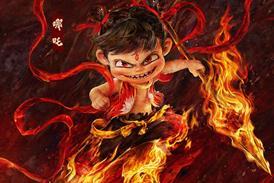Dir/Scr: Mark Hartley. Aust. 2008. 98 mins
Who’d have thought a documentary about Australian B-movies from the 1970s could be so much fun’ Opening proceedings at the Melbourne film festival (and destined for many more such events) documentary Not Quite Hollywood is movie geek heaven, irresistibly led by Quentin Tarantino as an enthusiastic master of ceremonies. In his debut feature, director/writer/editor Mark Hartley has crafted a surge of eye-popping clips and interviews with the verve of the award-winning pop videos for which he is noted.
Set to open on a respectable 50 screens in Australia at the end of August, this high-speed documentary should attract both arthouse and multiplex movie fans; respectable notices may attract a curious international following, and ancillary is certainly a good bet.
While Australia produced a handful of acclaimed 70s arty hits (1975’s Picnic at Hanging Rock, My Brilliant Career in 1979), there was also a long list of unsavoury, randy genre movies doing big business at local drive-ins. Strict Australian censorship was lifted in 1971 with the introduction of an R (restricted) classification and young filmmakers hit the open ground running, shedding clothes and inhibitions with sex, booze and vomit comedies such as Stork (1971), The Adventures of Barry McKenzie (1972) and Alvin Purple(1973).
Among Hartley’s talking heads is a witty Barry Humphries, revelling in his role of cultural terrorist and accompanied by a raft of actresses (and a few actors) who were required to go naked for low-budget employment. Now, to the beat of 70s hit singles, their oeuvre gets a second airing ain a dazzling split-screen montage of breasts, buttocks and pubic hair. Blatant exploitation was the order of the day.
Directors and producers cheerfully discuss their rough-edged, soft-core efforts including Richard Franklin’s The True Story of Eskimo Nell (1975), John D. Lamond’s Australia After Dark (1974) and other dubious sex ‘documentaries’. There was also Antony I. Ginnane, ‘The Roger Corman of Australia’, and his money spinners such as Patrick (1978), from which Tarantino here happily admits borrowing for Kill Bill.
Sex movies morphed into horror and Hartley’s montages add buckets of blood and gore to the naked flesh. Kung fu epic The Man From Hong Kong (1975) gets a nod, with contributions from director Brian Trenchard-Smith and cameraman Russell Boyd (who shot Hanging Rock that same year). Grizzled star George Lazenby shares memories of an unhappy shoot.
Biker movies led to car-chase-in-the-outback movies. ‘Nobody shoots a car the way the Aussies do,’ says Tarantino, and there’s a furious montage of high-speed, death-defying action, leading to the arrival of Mad Max in 1979. Director George Miller describes his shoot with the impossibly handsome young Mel Gibson as ‘gonzo filmmaking’, improvised and dangerous.
Denis Hopper contributes memories of his drugged, suicidal behaviour on the set of Mad DogMorgan in 1976, and other visitors from Hollywood and London speak with affection and bemusement, including Jamie Lee Curtis, Stacy Keach and Susannah York.
The pace never slackens and Tarantino’s extravagant enthusiasm here is winning, leading to a sense that a lost era of improvisation, experimentation and fun has been rescued from the vaults.
Production company
City Films Worldwide
International sales
Magnolia Pictures
+ 1 212 924-6701
Producers
Michael Lynch
Craig Griffin
Director of Photography
Karl von Moller
Editors
Jamie Blanks
Sara Edwards
Mark Hartley
Music
Stephen Cummings
Billy Miller
Main Interviewees:
Quentin Tarantino
Antony I. Ginnane
John D. Lamond
Barry Humphries
Phillip Adams
George Miller
Dennis Hopper
Grant Page



















No comments yet